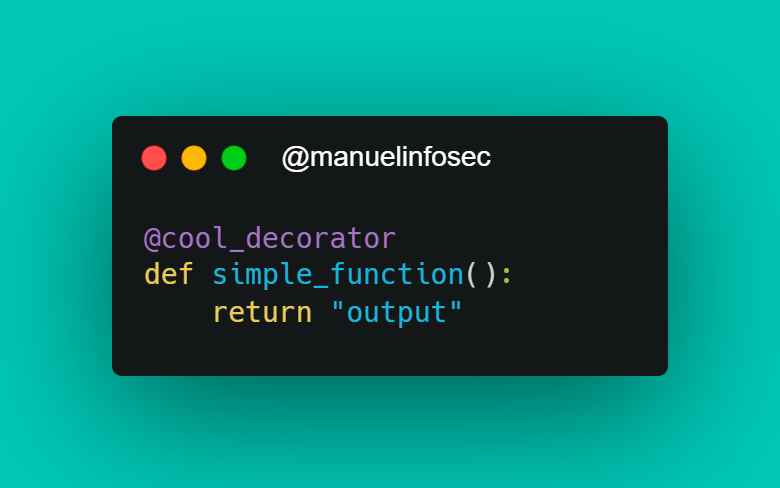
Hey there, fellow Pythonista! Ready to delve deeper into the enchanting world of Python decorators? Buckle up; we're about to take a journey into the heart of Python magic.
The Basics of Decorators
Let's start with the fundamentals. At its core, a decorator is a function that takes another function and extends or modifies its behavior. It's like a layer of magic that you can wrap around your existing code.
def my_decorator(func):
def wrapper():
print("Something is happening before the function is called.")
func()
print("Something is happening after the function is called.")
return wrapper
@my_decorator
def say_hello():
print("Hello!")
say_hello()
In this example, my_decorator wraps around say_hello, adding a touch of magic before and after the original function call.
Syntax Sugar - The '@' Symbol
Python adds a dash of style with the @ symbol, making decorators even more enjoyable to use. Instead of explicitly calling my_decorator, you can use @my_decorator above the function definition.
@my_decorator
def say_hello():
print("Hello!")
Why Should I Care?
Decorators are not just a fancy way to spice up your code; they bring tangible benefits. They enhance code readability, promote code reusability, and make your functions more versatile. Think of them as the secret sauce that can elevate your Pythonic creations.
"Decorators allow you to wrap another function to extend or modify its behavior. It's like giving your code a superhero cape." - Python Proverb
Decorators in Action
Now, let's explore some real-world scenarios where decorators shine.
Flask Web Framework
In Flask, decorators play a crucial role in defining routes. Check out this example:
Unwrapping Python Magic: A Deep Dive into Decorators
vbnet
Copy code
Unwrapping Python Magic: A Deep Dive into Decorators
Hey there, fellow Pythonista! Ready to delve deeper into the enchanting world of Python decorators? Buckle up; we're about to take a journey into the heart of Python magic.
The Basics of Decorators
Let's start with the fundamentals. At its core, a decorator is a function that takes another function and extends or modifies its behavior. It's like a layer of magic that you can wrap around your existing code.
def my_decorator(func):
def wrapper():
print("Something is happening before the function is called.")
func()
print("Something is happening after the function is called.")
return wrapper
@my_decorator
def say_hello():
print("Hello!")
say_hello()
less
Copy code
In this example, my_decorator wraps around say_hello, adding a touch of magic before and after the original function call.
Syntax Sugar - The '@' Symbol
Python adds a dash of style with the @ symbol, making decorators even more enjoyable to use. Instead of explicitly calling my_decorator, you can use @my_decorator above the function definition.
@my_decorator
def say_hello():
print("Hello!")
css
Copy code
Why Should I Care?
Decorators are not just a fancy way to spice up your code; they bring tangible benefits. They enhance code readability, promote code reusability, and make your functions more versatile. Think of them as the secret sauce that can elevate your Pythonic creations.
"Decorators allow you to wrap another function to extend or modify its behavior. It's like giving your code a superhero cape." - Python Proverb
Decorators in Action
Now, let's explore some real-world scenarios where decorators shine.
Flask Web Framework
In Flask, decorators play a crucial role in defining routes. Check out this example:
from flask import Flask
app = Flask(name)
@app.route('/')
def hello_world():
return 'Hello, World!'
The @app.route('/') decorator tells Flask to associate the hello_world function with the root URL ('/'). It's a concise way to define routes.
Django Framework
Django, a heavyweight in web development, leverages decorators for authentication. Here's a snippet:
from django.contrib.auth.decorators import login_required
@login_required
def my_secure_view(request):
return HttpResponse('Secret content!')
The @login_required decorator ensures that only authenticated users can access my_secure_view. It's a powerful tool for securing views in web applications.
Pitfalls and Common Errors
While decorators are a powerful tool, they come with their set of challenges. One common mistake is forgetting to return the inner wrapper function:
Oops! Missing return statement
def my_decorator(func):
def wrapper():
print("Something is happening before the function is called.")
func()
print("Something is happening after the function is called.")
# return statement missing!
Always ensure that the innermost function is returned; otherwise, your decorator won't work as expected.
Who's Who in the Decorator World?
Several influential figures in the Python community have left their mark on the decorator landscape. Let's tip our hats to a few of them:
- Guido van Rossum: The BDFL (Benevolent Dictator For Life) of Python, Guido has written extensively about decorators.
- Raymond Hettinger: A Python core developer and captivating speaker, Raymond's talks on decorators are both enlightening and entertaining.
- Dan Bader: Author of the popular book "Python Tricks," Bader dives deep into decorators in a beginner-friendly way.
Frequently Asked Questions
Q: Can I use multiple decorators on one function?
A: Absolutely! Just stack them on top of each other, and let the magic happen.
@decorator1
@decorator2
@decorator3
def my_function():
# Your code here
Q: Are decorators only for functions?
A: While decorators are commonly used with functions, they can also be applied to methods in classes.
Q: Can I create my own decorators?
A: Of course! Get creative and start decorating your code with your custom wrappers.
And there you have it – a deep dive into the enchanting world of Python decorators. So, go ahead, sprinkle a bit of magic into your code, and let your functions dance to the tune of decorators!

